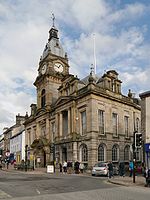Kendal Museum

Kendal Museum is a local museum in Kendal, Cumbria, on the edge of the Lake District in northwest England. It was founded in 1796 and includes collections of local archaeology, history, and geology, and a natural history collection from around the globe. The museum also features a changing programme of temporary exhibitions and displays, events, walks, and talks. The museum has a large natural history taxidermy collection, and features a stuffed polar bear and a model of a dodo. The museum is open three days a week from Thursday to Saturday, with a charge of £5 (adults) and £2 (5-18's) for admission, with Under 5's going free. The opening hours are 9.30am to 4.45pm with last entry at 4pm. In April 2011, Kendal Museum achieved the Visitor Attraction Quality Assurance Scheme assessment, awarded by Visit England.Kendal Museum is managed by Kendal College on behalf of South Lakeland District Council. and is part of the Arts and Media campus at the North End of Kendal.
Excerpt from the Wikipedia article Kendal Museum (License: CC BY-SA 3.0, Authors, Images).Kendal Museum
Station Road,
Geographical coordinates (GPS) Address Phone number Website External links Nearby Places Show on map
Geographical coordinates (GPS)
| Latitude | Longitude |
|---|---|
| N 54.3315 ° | E -2.742 ° |
Address
Kendal Museum
Station Road
LA9 6BT , Mintsfeet
England, United Kingdom
Open on Google Maps










